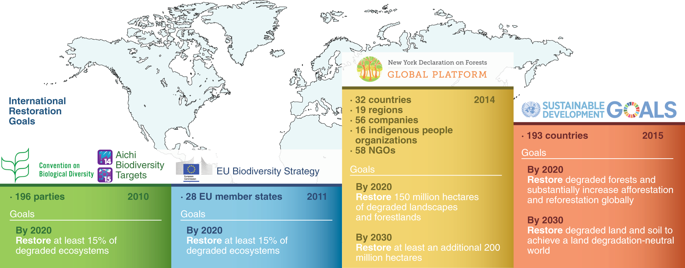当前位置:
X-MOL 学术
›
Nat. Ecol. Evol.
›
论文详情
Our official English website, www.x-mol.net, welcomes your
feedback! (Note: you will need to create a separate account there.)
The long-term restoration of ecosystem complexity.
Nature Ecology & Evolution ( IF 13.9 ) Pub Date : 2020-04-13 , DOI: 10.1038/s41559-020-1154-1 David Moreno-Mateos 1, 2, 3 , Antton Alberdi 4 , Elly Morriën 5, 6 , Wim H van der Putten 6, 7 , Asun Rodríguez-Uña 2 , Daniel Montoya 8
Nature Ecology & Evolution ( IF 13.9 ) Pub Date : 2020-04-13 , DOI: 10.1038/s41559-020-1154-1 David Moreno-Mateos 1, 2, 3 , Antton Alberdi 4 , Elly Morriën 5, 6 , Wim H van der Putten 6, 7 , Asun Rodríguez-Uña 2 , Daniel Montoya 8
Affiliation

|
Multiple large-scale restoration strategies are emerging globally to counteract ecosystem degradation and biodiversity loss. However, restoration often remains insufficient to offset that loss. To address this challenge, we propose to focus restoration science on the long-term (centuries to millennia) re-assembly of degraded ecosystem complexity integrating interaction network and evolutionary potential approaches. This approach provides insights into eco-evolutionary feedbacks determining the structure, functioning and stability of recovering ecosystems. Eco-evolutionary feedbacks may help to understand changes in the adaptive potential after disturbance of metacommunity hub species with core structural and functional roles for their use in restoration. Those changes can be studied combining a restoration genomics approach based on whole-genome sequencing with replicated space-for-time substitutions linking changes in genetic variation to functions or traits relevant to the establishment of evolutionarily resilient communities. This approach may set the knowledge basis for future tools to accelerate the restoration of ecosystems able to adapt to ongoing global changes.
中文翻译:

长期恢复生态系统的复杂性。
全球正在出现多种大规模的恢复战略,以应对生态系统退化和生物多样性丧失。但是,恢复通常仍然不足以弥补该损失。为了应对这一挑战,我们建议将恢复科学重点放在退化的生态系统复杂性的长期(几百年到几千年)重组中,并结合相互作用网络和进化潜力方法。这种方法提供了有关生态进化反馈的见解,这些反馈确定了正在恢复的生态系统的结构,功能和稳定性。生态进化反馈可能有助于了解在具有核心结构和功能作用的元社区中心物种受到干扰后,其适应潜力的变化,以供其恢复使用。可以结合基于全基因组测序的恢复基因组学方法和复制的时空替代方法(将基因变异的变化与建立进化适应性群落的功能或性状联系起来)相结合,研究这些变化。这种方法可以为将来的工具提供知识基础,以加速能够适应不断变化的全球生态系统的恢复。
更新日期:2020-04-24
中文翻译:

长期恢复生态系统的复杂性。
全球正在出现多种大规模的恢复战略,以应对生态系统退化和生物多样性丧失。但是,恢复通常仍然不足以弥补该损失。为了应对这一挑战,我们建议将恢复科学重点放在退化的生态系统复杂性的长期(几百年到几千年)重组中,并结合相互作用网络和进化潜力方法。这种方法提供了有关生态进化反馈的见解,这些反馈确定了正在恢复的生态系统的结构,功能和稳定性。生态进化反馈可能有助于了解在具有核心结构和功能作用的元社区中心物种受到干扰后,其适应潜力的变化,以供其恢复使用。可以结合基于全基因组测序的恢复基因组学方法和复制的时空替代方法(将基因变异的变化与建立进化适应性群落的功能或性状联系起来)相结合,研究这些变化。这种方法可以为将来的工具提供知识基础,以加速能够适应不断变化的全球生态系统的恢复。











































 京公网安备 11010802027423号
京公网安备 11010802027423号